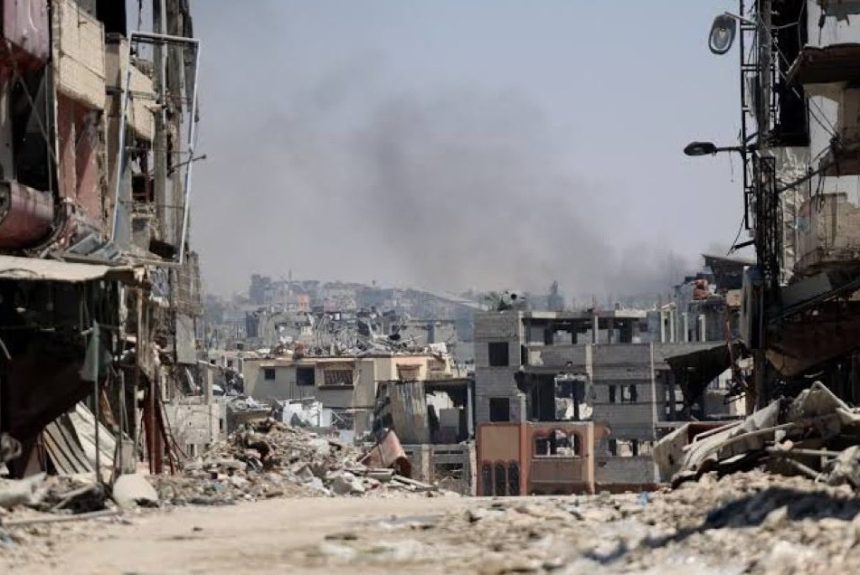Israel Resumes Killings in Gaza Amid Trump’s “Peace Plan” Fallout
Despite last week’s much-heralded ceasefire deal, Israeli forces have resumed lethal operations in Gaza, killing at least seven Palestinians over Monday and Tuesday.
The resumption of violence casts fresh doubt over the first stage of the Trump-brokered plan and its claimed withdrawal promise.
Medical sources told Al Jazeera that in Gaza City’s Shejaiya district on Tuesday, snipers shot dead five civilians, allegedly as they neared what is known as the “yellow line.”
The troops claim they were “neutralizing a threat” posed by those approaching Israeli positions.
Monday brought further bloodshed in Khan Yunis: local sources report that Khalid Barbakh was shot dead by Israeli forces while he was inspecting his home in the Al-Sikka area.
The phrase “yellow line” is at the heart of the current controversy. This line is neither Gaza’s border nor a neutral demarcation.
It’s a boundary drawn inside the enclave, enabling Israel to retain military dominance over strategic zones, including parts of Rafah, Khan Younis, the Philadelphi Corridor, and northern Gaza.
Under the ceasefire agreement’s first phase, Israel is meant to withdraw to this yellow line, though in practice its forces remain behind it, maintaining control.
The plan envisions later phases: an international overseer, transitional governance, and a “red line” marking further Israeli retreat.
Eventually, Israeli control would be confined to a narrow buffer zone along the Gaza–Israel border. But the recent killings suggest those later phases may simply be rhetorical.
Israel’s military insists those shot were “suspects” who “crossed the yellow line”, a claim at odds with the intended troop withdrawal stipulated in the peace accord.
Eyewitness and hospital accounts describe chaos and unexpected firing. “The Israeli soldiers began firing without warning,” one survivor told reporters outside al-Ahli Arab Hospital in Gaza City.
Amal al-Saqqa, a local resident, added: “We heard the ceasefire was in place, so we tried to go back to our homes. The shooting began before we could even reach the yellow line.”
In statements issued Tuesday, the IDF defended its actions: “Soldiers took action to protect themselves against individuals attempting to approach and compromise our positions in northern Gaza.
We will defend our forces and our mandate under the October 10 agreement.”
Meanwhile, maps coming from Trump’s negotiation team show that more than half of Gaza remains under Israeli occupation — despite claims of meaningful withdrawal.
This discrepancy intensifies concerns about how much the so-called ceasefire is actually constraining Israel’s military reach.
Critics are blunt. They view the operation as proof that Trump’s plan is designed not for peace, but for perpetuating Israel’s grip on Gaza and denying Palestinian sovereignty.
The resumed violence, especially so soon after the ceasefire, is cited as evidence that the agreement “does nothing to restrain Israeli violence.”
#BREAKING: The Israeli is already bombing Gaza again, Shujaiya, east of Gaza City pic.twitter.com/b2MBO4ZLvR
— Syrian Girl (@Partisangirl) October 14, 2025
The humanitarian consequences are stark. Israel has continued to throttle aid routes even under the truce. The Rafah crossing into Egypt remains shut.
The agreed number of daily aid trucks has been cut in half, from 600 to 300. Israeli officials say the restrictions are a sanction for Hamas’s delayed return of bodies from the hostages deal.
Behind these operational measures lies Israel’s strategy of using the blockade as leverage. Official justifications claim the cuts punish “Hamas until all bodies of slain hostages are returned.” In effect, the civilian population bears the cost.
UN agencies warn of further deterioration: mounting food shortages, critical lack of medical supplies, and widespread displacement.
Hospitals operate with skeleton resources; infrastructure rebuilding promised in the ceasefire has barely begun.
Though 55 detained health workers were released in the prisoner exchange, at least 115 remain held.
The Trump administration, backed by rudiments of the US media and political establishment, continues to herald the agreement as a corner success. But the irony is unmistakable; the killings proceeded precisely as the ceasefire was meant to take hold.
Adding to the extremity, violence has entwined in the West Bank. Over the last three days, settlers and Israeli forces launched attacks on Palestinian communities during the olive crop season, targeting intelligencers, homes, and cropland in places like Nablus, Beita, Huwara, Deir Sharaf, and Bardala.
In one incident, 150 olive trees were destroyed; in another, assailants unleashed tykes against civilians.
The Palestine Red Crescent treated scores of injuries. spectators say the pattern is increasingly coordinated. Over 1,000 settler attacks have passed so far in 2025 alone, substantially concentrated in Ramallah, Nablus, and Hebron.
Since October 2023, further than 1,000 Palestinians have been injured and nearly 10,000 have been wounded in the West Bank from analogous violence.
The surge in settler aggression is viewed as part of Israel’s broader campaign of expanding territorial control by stealth, often justified under security rhetoric.
The United Nations reports at least 3,400 Palestinians displaced by such actions and restrictions across Gaza and the West Bank during the conflict and beyond.






